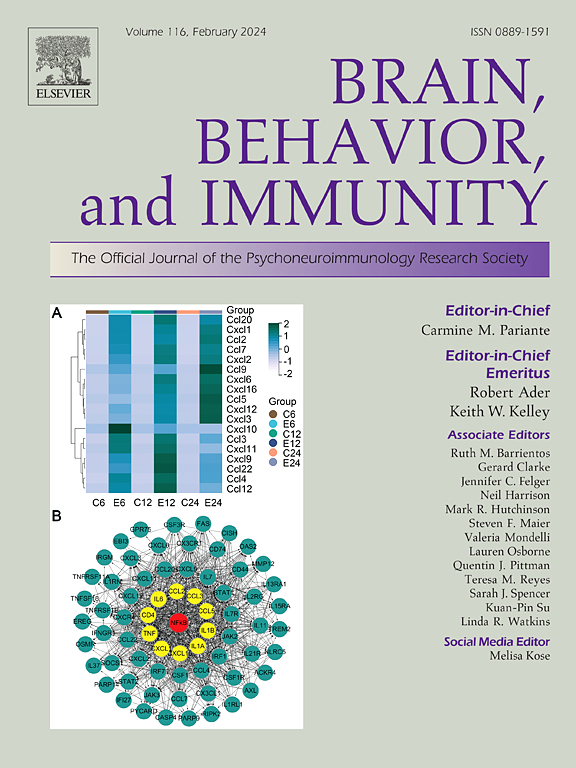Chemogenetic targeting TRPV1 in obesity-induced depression: Unveiling therapeutic potential of eicosapentaenoic acid and acupuncture
IF 8.8
2区 医学
Q1 IMMUNOLOGY
引用次数: 0
Abstract
The comorbidity of obesity and depression has major public health impacts, highlighting the need to understand their shared mechanisms. This study explored the connection between obesity and depression through the transient receptor potential V1 (TRPV1) signaling pathway, using obese/depressed murine models and clinical data. Mice fed a high-fat diet showed altered TRPV1 pathway expression in brain regions of the mice: downregulated in the medial prefrontal cortex (mPFC) and hippocampus, and upregulated in the hypothalamus and amygdala, influencing depression-like behaviors and inflammation. Treatments like eicosapentaenoic acid (EPA) and acupoint catgut embedding (ACE) reversed these effects, similar to observations in Trpv1−/− mice. Furthermore, chemogenetic activation in the ventral mPFC also alleviated depression via TRPV1. In our clinical validation, single nucleotide polymorphisms (SNPs) in TRPV1-related genes (PIK3C2A and PRKCA) were linked to interferon-induced depression. These findings underscore the potential of targeting TRPV1 as a therapeutic approach for obesity-related depression.
在肥胖诱发的抑郁症中针对 TRPV1 的化学遗传学:揭示二十碳五烯酸和针灸的治疗潜力
肥胖症和抑郁症的并发症对公众健康产生了重大影响,因此需要了解它们的共同机制。这项研究利用肥胖/抑郁小鼠模型和临床数据,通过瞬时受体电位V1(TRPV1)信号通路探索肥胖与抑郁之间的联系。以高脂肪饮食喂养的小鼠脑区的TRPV1通路表达发生了改变:内侧前额叶皮层(mPFC)和海马下调,下丘脑和杏仁核上调,从而影响了抑郁样行为和炎症。二十碳五烯酸(EPA)和穴位埋线(ACE)等治疗方法可逆转这些影响,这与在Trpv1-/-小鼠身上观察到的结果相似。此外,腹侧 mPFC 的化学激活也能通过 TRPV1 缓解抑郁。在我们的临床验证中,TRPV1相关基因(PIK3C2A和PRKCA)中的单核苷酸多态性(SNPs)与干扰素诱导的抑郁有关。这些发现强调了靶向 TRPV1 作为肥胖相关抑郁症治疗方法的潜力。
本文章由计算机程序翻译,如有差异,请以英文原文为准。
求助全文
约1分钟内获得全文
求助全文
来源期刊
CiteScore
29.60
自引率
2.00%
发文量
290
审稿时长
28 days
期刊介绍:
Established in 1987, Brain, Behavior, and Immunity proudly serves as the official journal of the Psychoneuroimmunology Research Society (PNIRS). This pioneering journal is dedicated to publishing peer-reviewed basic, experimental, and clinical studies that explore the intricate interactions among behavioral, neural, endocrine, and immune systems in both humans and animals.
As an international and interdisciplinary platform, Brain, Behavior, and Immunity focuses on original research spanning neuroscience, immunology, integrative physiology, behavioral biology, psychiatry, psychology, and clinical medicine. The journal is inclusive of research conducted at various levels, including molecular, cellular, social, and whole organism perspectives. With a commitment to efficiency, the journal facilitates online submission and review, ensuring timely publication of experimental results. Manuscripts typically undergo peer review and are returned to authors within 30 days of submission. It's worth noting that Brain, Behavior, and Immunity, published eight times a year, does not impose submission fees or page charges, fostering an open and accessible platform for scientific discourse.

 求助内容:
求助内容: 应助结果提醒方式:
应助结果提醒方式:


